Fery
International Hazard
    
Posts: 1026
Registered: 27-8-2019
Location: Czechoslovakia
Member Is Offline
|
|
aldol condensation of acetone on calcium carbide
My goal was to prepare mesityl oxide as I was interested in its scent. Diacetone alcohol does not have any interesting scent. This reaction has an
advance that there is only little of higher steps condensation side products as fresh acetone quickly washes out products from the catalyst.
This is not any recipe how you should repeat this experiment. It is meant as a help if you try it. The first part (reaction itself) seems to be quite
satisfactory. But you should improve especially the second part (separation).
Into 1 L 3-neck RBF was put 500 g of acetone (weighed, the volume should be above 600 ml). Into one neck was put short stem thermometer to record
temperature of vapors and into second neck long stem thermometer which was submersed into the liquid. 5 small glass balls were added to facilitate
boiling and to prevent bumping (boiling was smooth and no bumping observed).
Into 250 ml dropping funnel with pressure equalization tube was put enough glass wool (few cm layer is necessary) and 200 g of technical calcium
carbide (only lumps without dust, lumps which passed through 29/32 ground glass joint of the dropping funnel). Note 1 - if you want to speedup the
reaction and save few hours of reflux, crush CaC2 to smaller pieces, 1/2 cm size instead of 1-2 cm should speedup the reaction few times as the
surface should be much higher). On the other side, bigger lumps and slower evolution of C2H2 could be safer as the acetylene has explosive properties
when mixed with air. Electrical heating mantle is safer, do not use flame heater. There is no need of magnetic stirring, 5 small glass balls were
satisfactory to prevent bumping.
Dropping funnel with CaC2 was mounted into third neck of the RBF. Efficient condenser was attached to the top of dropping funnel. To the top of
condenser was attached an adapter connected with a hose leading gases outside of building.
The apparatus was put inside heating mantle and reflux commenced.
Temperature of vapor registered by short stem thermometer was 54,5 C on the beginning (a little of condensate from the neck decreased the temp a bit
as b.p. of acetone is 56 C). Temperature of boiling liquid registered by long stem thermometer immersed in boiling liquid was 57,6 C.
After 30 minutes of reflux the long stem recorded 58,4 C.
After 1 hour long stem thermometer 59,0 C and short stem 55,0 C.
After 2 hours the downflow in the dropping funnel insufficient due to Ca(OH2) slowing down filtration through glass wool (that's why I suggested to
use enough thick layer of the wool) so the condensate in the funnel formed visible level which established an equilibrium. The level slowly raised but
did not reach the upper part of the equalization tube (if raised too high it could be coped by reducing heat power thus lowering influx of acetone
from condenser). Also narrower and taller dropping funnel is advised as the level of condensate is higher so filtration faster.
After 2,5 hours the level of liquid in dropping funnel raised 3 cm below upper aperture of equalization tube so heating power was slightly reduced,
the level did not raise further and lowered a little. As temperature later raised too, less acetone was distilled/condensed per time interval which
facilitated preventing raising of the level in dropping funnel.
Time 4 h 30 minutes long stem thermometer 85 C
Time 5 hours 90 C.
5 hours 45 minutes 100 C long stem and 70 C short stem.
6 hours 20 minutes 115 C long stem thermometer = temperature of boiling liquid in RBF and short stem thermometer 77 C = temperature of vapor. Reflux
finished.
The content from RBF filtered through filter paper into clean 1 L 1 neck RBF as there was a little of solid at milligram scale.
Now I did column distillation but you shouldn't just right now. You could probably do simple distillation. Later I will explain the reason why. Now my
observations during column distillation:
1 m long 3 cm inner diameter Hempel column packed with Raschig rings (glass tubes 0,5 cm diameter 0,5 cm long 1 mm thick wall) insulated with paper
and glass tube of 5 cm diameter (vacuum insulated would be better but too expensive) and adjustable variable reflux ratio distillation head were used.
Acetone fraction b.p. 55,0 C - 57,0 C collected circa 100 ml (I did not measure exactly the volume).
Fraction 57,5 C - 124,5 C circa 30 ml (I was waiting for b.p. of mesityl oxide 129,5 C but this did not happen).
Fraction which started at 125,0 C was collected but the T did not raise anymore and during time it started to decrease so I collected everything until
T reached 120,0 C. Fraction weighed 56,4 g.
The fraction boiling below 120,0 C collected and T continually decreased finally to 98,0 C. Notice the heating was almost at max and the reflux flow
massive. Now I turned heating off and after some time the T recorded by thermometer raised above 100 C. Yeah, when heating the T was falling and when
turning off heating it raised. Too much heating decomposed the compound and strong heating is necessary for column distillation to cause enough reflux
flow through column.
Conclusion: High temperature and massive heating caused decomposition of diacetone alcohol (b.p. 166 C) into mesityl oxide + water + acetone and the
b.p. of this azeotrope is below 100 C.
So I suggest simple distillation to convert diacetone alcohol to mesityl oxide, remove water and only then column distillation. But that's only my
idea, finally it could be not so easy.
The residuum from RBF was distilled using simple distillation, b.p. started below 100 C and finished above 155 C, this distillate was slightly
yellowish unlike collum distillation where distillate completely colorless. Circa 150 ml collected.
Now I understand why they used vacuum distillation to obtain diacetone alcohol here, they state that at atmospheric pressure thus higher temperature
of boiling, some diacetone alcohol decomposes into acetone:
http://orgsyn.org/demo.aspx?prep=cv1p0199
So the separation of acetone + mesityl oxide + diacetone alcohol is very challenging task which I did not yet fully solve how to perform it. Water
could be eventually removed using CaC2 and acetone using column distillation.
referrence:
https://pubs.rsc.org/en/content/articlehtml/2018/ra/c8ra0596...
https://sci-hub.3800808.com/10.1039/C8RA05965A
Attachment: C8RA05965A.pdf (835kB)
This file has been downloaded 152 times
[Edited on 28-2-2023 by Fery]
|
|
|
Fery
International Hazard
    
Posts: 1026
Registered: 27-8-2019
Location: Czechoslovakia
Member Is Offline
|
|
pics synthesis:
apparatus, note later I had to replace the dropping funnel with new one as its stopcock was leaking acetone
 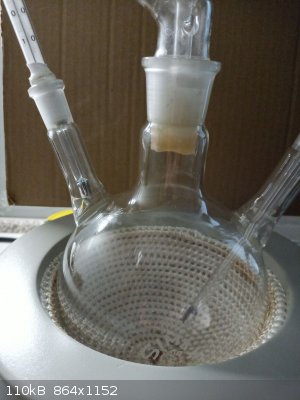
reflux started
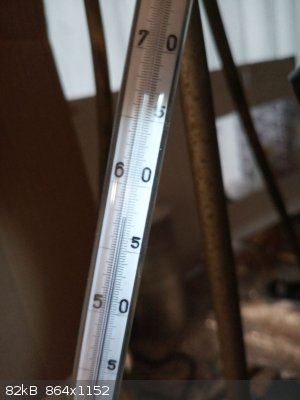 
half an hour, the condensate still managed to filter quickly into RBF, no visible level of condensate in dropping funnel
 
after 2 hours there was already thick enough layer of Ca(OH)2 which slowed down filtration so a level of condensate appeared in the middle of dropping
funnel
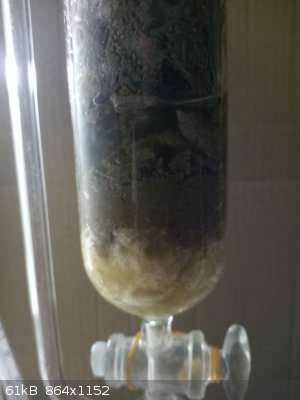 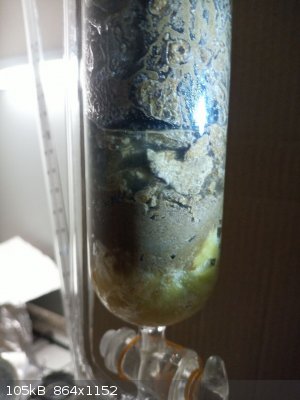
after 4 hours 45 minutes
 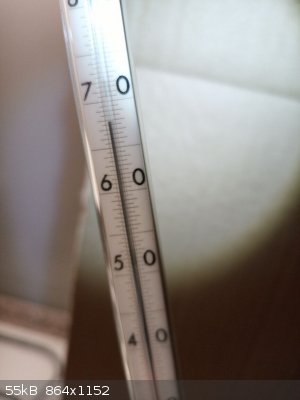 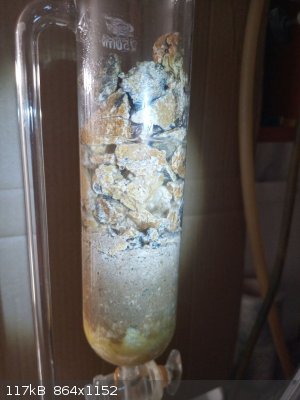 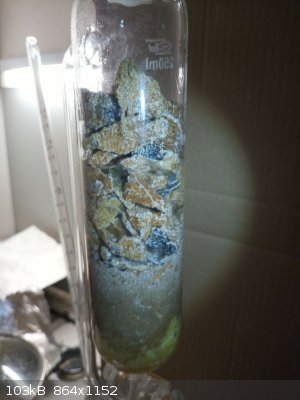 
after 5 hours 15 minutes
 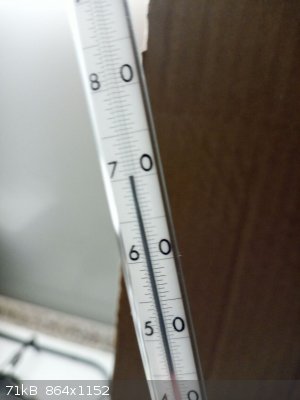 
after 5 hours 45 minutes
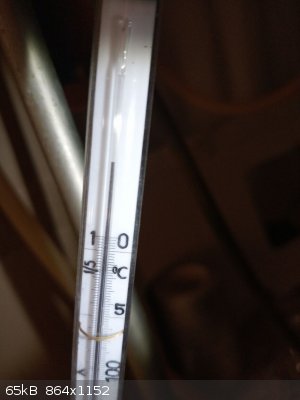   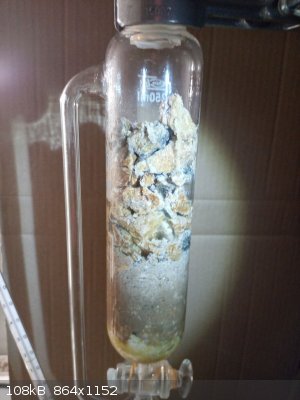
final reaction mixture

|
|
|
Fery
International Hazard
    
Posts: 1026
Registered: 27-8-2019
Location: Czechoslovakia
Member Is Offline
|
|
pics distillation (this part should be done differently, but I did not know at that moment)
column distillation, apparatus, insulation, details
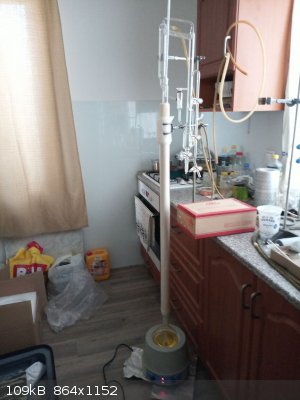  
collecting acetone fraction

the rest of column distillation is not worth to post
simple distillation of remainder after column distillation, note the foaming at the end, luckily I used magnetic stirring for this distillation
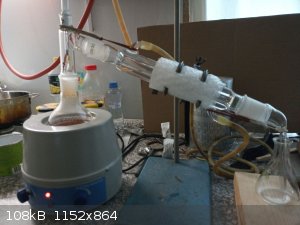   
|
|
|
Deathunter88
National Hazard
   
Posts: 522
Registered: 20-2-2015
Location: Beijing, China
Member Is Offline
Mood: No Mood
|
|
Mesityl oxide is not very soluble in water, diacetone alcohol and acetone both are, so wouldn't a water washing help separate them?
|
|
|
Fery
International Hazard
    
Posts: 1026
Registered: 27-8-2019
Location: Czechoslovakia
Member Is Offline
|
|
Deathunter88 you are right, that could be a way to go to separate mesityl oxide. Solubility of mesityl oxide in water 3% (20°C) https://en.wikipedia.org/wiki/Mesityl_oxide
|
|
|
kmno4
International Hazard
    
Posts: 1503
Registered: 1-6-2005
Location: Silly, stupid country
Member Is Offline
Mood: No Mood
|
|
I do not understand why to use so complex procedure for obtaining mesityl oxide(MO).
Just acetone -> diacetone alcohol (DAA), then DAA + cat. iodine-> MO + H2O.
In the system: water-DAA-MO-acetone, only binary azeotropes (MO-H2O and DAA-H2O) are formed and separate acetone fraction.
No other azeotropes are formed.
Azeotropes MO-H2O and DAA-H2O easy to separate on the column (boiling points are ~92 C and ~100 C)
Слава Україні !
Героям слава !
|
|
|
zero
Harmless

Posts: 19
Registered: 14-9-2022
Member Is Offline
|
|
I attempted the acetone + CaOH -> DAA + iodine -> MO route.
200g unknown water content acetone added to 1L round bottom with 20g CaOH.
Stirred for 2 hours with stirplate.
Gravity filtered through funnel plugged with cotton and took over an hour. Once CaOH layer was deep, progress was slowed.
Return to 1L round bottom and distill most acetone.
Left with around 30ml of acetone,water,DAA.
Add small amount (less than gram) of freshly made wet iodine to solution where it dissolves.
Fractionally distill with vigreux. Around 10 ml of acetone come over first. Next 10ml of water and MO,DAA azeotropes. Temperature quickly rises to
131C and 6ml of MO come over before distillation slows and is ended.
Product is slightly yellow oily liquid with strange smell. Supposed to be like honey but doesn't smell like that to me. Very different from acetone.
Lessons: Use dry acetone, decant CaOH from acetone/DAA before filtering, dry iodine after making, attempt to recover MO from water azeotrope, buy
soxhlet extractor to avoid bad yield in first reaction.
acetone -> DAA: US1550792A
DAA -> MO: 10.15227/orgsyn.001.0053
|
|
|
Fery
International Hazard
    
Posts: 1026
Registered: 27-8-2019
Location: Czechoslovakia
Member Is Offline
|
|
zero thanks for sharing useful practical info about your experiment and also the links!
Ca(OH)2 has big surface and small particles so that expect loses of liquid product. The glass equipment needs grassing all joints or PTFE sleeves for
joints and efficient condenser + cooling with quite cold water due to low b.p. of acetone. Decanting liquid from fine Ca(OH)2 - there still remains a
lot of liquid adhering to solid. If somebody has an idea to recover liquid from solid by distillation, then be careful. Certainly do not distill a
mixture of Ca(OH)2 + flammable liquid using naked flame - I did that as a boy (attempt for anhydrous ethanol) and the flask of course cracked due to
overheating underneath solid Ca(OH)2 settled to the bottom - so I made a small fire in the lab.
|
|
|
zero
Harmless

Posts: 19
Registered: 14-9-2022
Member Is Offline
|
|
Good tips Fery. Joints were not greased and acetone was leaking, next time will try teflon tape. For product trapped in Ca(OH)2, better to not worry
about since majority of product is in decanted acetone. If running reaction again can reuse acetone filled Ca(OH)2 left after decanting. If have
soxhlet extractor, use according to: 10.15227/orgsyn.001.0045 instead for much higher yield. Ca(OH)2 should work instead of Ba(OH)2, takes longer.
[Edited on 31-5-2023 by zero]
|
|
|